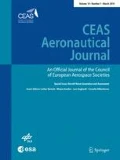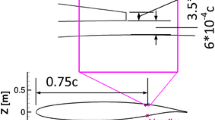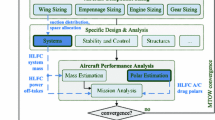Abstract
Active high-lift technologies have often proven their potential in aerodynamic analyses and wind tunnel tests, but have so far played only a minute role in civil production aircraft. This is expected to change in the future only if such technologies can be accounted for early in the aircraft design process. In this paper, the adaptation of a conceptual design process is presented, enabling it to consider circulation control as a high-lift technology. It is shown that the main aerodynamic effects of a blown flap in the boundary layer control regime can be satisfactorily modeled with a potential theory method. Some sample results of the design process indicate a potential for significant reductions of required field length in comparison with today’s aircraft, creating the potential to increase the capacity of the air transportation system, without increasing overall aircraft mass or direct operating cost.

























Similar content being viewed by others
Abbreviations
- A :
-
Cross-section area of BLC exit slot, in m²
- A :
-
Speed of sound, in m/s
- B :
-
Width, in m
- C D0 :
-
3D zero-lift drag coefficient
- C Di :
-
3D induced drag coefficient
- c dF :
-
2D drag coefficient with flap extended
- c dF0 :
-
2D drag coefficient without flap extension
- C L :
-
3D lift coefficient
- c l :
-
2D lift coefficient
- C M :
-
3D pitching moment coefficient
- \( C_{{{\upmu}}} \) :
-
3D blowing momentum coefficient
- \( c_{{{\upmu}}} \) :
-
2D blowing momentum coefficient
- c p :
-
Pressure coefficient
- F F :
-
Wing reference area, in m²
- i :
-
Counter over wing sections
- j :
-
Index denoting parameters of the BLC jet
- L/D :
-
Relation of lift to drag
- \( \dot{m} \) :
-
Mass flow, in kg/s
- Ma:
-
Mach number
- p :
-
Static pressure, in Pa
- \( p_{\text{T}} \) :
-
Total pressure, in Pa
- q :
-
Dynamic pressure, in Pa
- T :
-
Static temperature, in K
- T T :
-
Total temperature, in K
- t n :
-
Chord length normal to the wing leading edge, in m
- V :
-
Velocity, in m/s
- \( \alpha \) :
-
Angle of attack, in degrees
- \( \gamma \) :
-
Dimensionless circulation
- \( \varphi_{ 2 5} \) :
-
Wing sweep angle at quarter-chord, in degrees
- \( \eta \) :
-
Dimensionless span coordinate
- \( \kappa \) :
-
Ideal gas coefficient
- \( \Uplambda \) :
-
Wing aspect ratio
- \( \rho \) :
-
Density, in kg/m³
References
Warwick, G.: Forward pitch. Aviat. Week Space Technol. 169(15), 22–26 (2008)
Werner-Spatz, C.: Flugzeuggesamtentwurf mit Zirkulationskontrolle am Hochauftriebssystem. Ph.D. Dissertation, Technische Universität Braunschweig, Braunschweig, Germany, 2010
Rudolph, P.K.: High-lift systems on commercial subsonic airliners, NASA CR-4746 (1996)
Woodward, D., and Lean, D., “Where is High-Lift Today? - A Review of Past UK Research Programmes”, High-Lift System Aerodynamics, AGARD CP-515, 1993
Werner-Spatz, C., Heinze, W., Horst, P.: Improved representation of high-lift devices for a multidisciplinary conceptual aircraft design process. J. Aircraft 46(6), 1984–1994 (2009). doi:10.2514/1.42845
Nicolai, L.M.: Fundamentals of aircraft design. METS Inc., San Jose (1975)
Torenbeek, E.: Synthesis of subsonic airplane design. Delft University Press, Martinus Nijhoff Publishers, Delft, Den Haag (1982)
Raymer, D.P.: Aircraft Design: A Conceptual Approach. AIAA, Reston (2006)
Howe, D.: Aircraft Conceptual Design Synthesis. Professional Engineering Publishing, Suffolk (2000)
Schlichting, H., Truckenbrodt, E.: Aerodynamik des Flugzeuges. Springer Verlag, Berlin (1967)
McCormick, B.W.: Aerodynamics of V/STOL Flight. Dover Publications, Mineola (1999)
Prandtl, L.: Über Flüssigkeitsbewegung bei sehr kleiner Reibung. Verhandlungen des III. Internationalen Mathematischen Kongresses, Heidelberg, Germany (1904)
Betz, A.: History of Boundary Layer Control in Germany, Boundary Layer and Flow Control. Pergamon Press, Oxford (1961)
Lachmann, G. (ed.): Boundary Layer and Flow Control. Pergamon Press, Oxford (1961)
Williams, J.: British Research on the Jet-Flap Scheme. Zeitschrift für Flugwissenschaften 6, 170–176 (1958)
Williams, J., Butler, S., Wood, M.: The Aerodynamics of Jet Flaps. In: Proceedings of the 2nd International Congress on Aeronautical Sciences, Zurich, Switzerland (1960)
Davidson, I.: Some Engineering Problems of the Jet Flap: Boundary Layer and Flow Control. Pergamon Press, Oxford (1961)
Spence, D.: The lift coefficient of a thin jet-flapped wing. In: Proceedings of the Royal Society London, (A) 238 (1956)
Wygnanski, I., Newman, B.: The effect of jet entrainment on lift and moment for a thin aerofoil with blowing. Aeronaut. Quart. 15, 122–150 (1964)
Das, A.: Tragflächentheorie für Tragflügel mit Strahlklappen. Jahrbuch der Wissenschaftlichen Gesellschaft für Luftfahrt e.V., pp. 112–133 (1960)
Gratzer, L.: Analysis of Transport Applications for High-Lift Schemes. Assessment of Lift Augmentation Devices, AGARD LS-43 (1971)
Roberts, L.: Short-Haul transportation in the 1980s. STOL Technology, NASA SP-320 (1972)
Quigley, H.C., Vomakse, R.F.: Preliminary Results of Flight Tests of the Augmentor-Wing Jet STOL Research Aircraft. STOL Technology, NASA SP-320 (1972)
Whittley, D.: An Update of the Canada/USA. Augmentor-Wing Project. Improvement of Aerodynamic Performance Through Boundary Layer Control and High Lift Systems, AGARD CP-365 (1984)
Anon: Powered-Lift Aerodynamics and Acoustics, NASA SP-406 (1976)
Englar, R.J.: Circulation control for high lift and drag generation on STOL aircraft. J. Aircraft 12(5), 457–463 (1975)
Wood, N., Nielsen, J.: Circulation control airfoils past, present, future. In: Proceedings of the 23rd AIAA Aerospace Sciences Meeting, Reno, NV (1985)
Anon: Proceedings of the Circulation Control Workshop, NASA CP-2432 (1986)
Jones, G.S., Joslin, R.D. (ed.): Proceedings of the 2004 NASA/ONR Circulation Control Workshop, NASA CP-2005-213509 (2005)
Levinsky, E.S., Ramsey, J.C.: Methodology for estimating STOL aircraft high lift systems characteristics. AIAA Paper 1972–1779 (1972)
Hooper, J., White, E., Hillier, H.: Lift-augmentation devices and their effect on the engine. In: Assessment of Lift Augmentation Devices, AGARD LS-43 (1971)
Conlon, J.A., Bowles, J.V.: Powered lift and mechanical flap concepts for civil short-haul aircraft. J. Aircraft 15(2), 168–174 (1978)
Anders, S.G., Sellers, W.L.I., Washburn, A.E.: Active flow control activities at NASA Langley. In: Proceedings of the 2nd AIAA Flow Control Conference, Portland, OR, AIAA (2004)
Kibens, V., Bower, W.W.: An overview of active flow control applications at The Boeing Company. In: Proceedings of the 2nd AIAA Flow Control Conference, Portland, OR, AIAA (2004)
Hak, M.G.: Flow control: the future. J. Aircraft 38(3), 402–418 (2001)
Shmilovich, A., Yadlin, Y.: Flow control for the systematic buildup of high-lift systems. J. Aircraft 45(5), 1680–1688 (2008)
Meunier, M., Brunet, V.: High-lift devices performance enhancement using mechanical and air-jet vortex generators. J. Aircraft 45(6), 2049–2061 (2008)
Radespiel, R., Pfingsten, K.-C., Jensch, C.: Flow analysis of augmented high-lift systems. In: Radespiel, R., Rossow, C.-C., Brinkmann, B. (eds.) Hermann Schlichting—100 Years. Scientific Colloquium Celebrating the Anniversary of his Birthday, Braunschweig, Germany 2007. Notes on Numerical Fluid Mechanics and Multidisciplinary Design, vol. 102. Springer-Verlag, Berlin. ISBN 978-3-540-95997-7 (2009)
Pfingsten, K.-C., Cecora, R.D., Radespiel, R.: An experimental investigation of a gapless high-lift system using circulation control. In: Proceedings KATnet II Conference on Key Aerodynamic Technologies, Bremen, Germany (2009)
Jensch, C., Pfingsten, K.C., Radespiel, R., Schuermann, M., Haupt, M., Bauss, S.: Design Aspects of a Gapless High-Lift System With Active Blowing, Deutscher Luft- und Raumfahrtkongress, Aachen, Germany (2009)
Bushnell, D.M.: Application Frontiers of “Designer Fluid Mechanics”—Vision Versus Reality”, AIAA Paper 97-2110 (1997)
Sellers, W.L.I., Singer, B.A., Leavitt, L.D.: Aerodynamics for Revolutionary Air Vehicles. In: Proceedings of the 21st Applied Aerodynamics Conference, Orlando, FL (2003)
Roskam, J.: Airplane Design. Design, Analysis and Research Corporation, Lawrence (1997)
Finck, R.D.: USAF (United States Air Force) Stability and Control DATCOM (Data Compendium). McDonnell Aircraft Co., St. Louis (1978)
Pepper, R., van Dam, C., Gelhausen, P.: Design methodology for high-lift systems on subsonic transport aircraft. In: Proceedings of the 6th AIAA/NASA/ISSMO Symposium on Multidisciplinary Analysis and Optimization, Bellevue, WA (1996)
de Mello, R.S., Soviero, P.A.O.: A simplified conceptual design high-lift methodology for transport aircraft. In: Proceedings of the 22nd AIAA Applied Aerodynamics Conference and Exhibit, Providence, RI (2004)
Keen, E.B., Mason, W.H.: A conceptual design methodology for predicting the aerodynamics of upper surface blowing on airfoils and wings. In: Proceedings of the 23rd AIAA Applied Aerodynamics Conference, Toronto, Canada (2005)
Kehse, T.: Gesamtentwurf von Flugzeugen mit Hochauftriebshilfen nach dem Prinzip des Upper Surface Blowing. Deutscher Luft- und Raumfahrtkongress 2008. Darmstadt, Germany (2008)
Kirby, M.R., Mavris, D.N.: Forecasting technology uncertainty in preliminary aircraft design. In: Proceedings of the 1999 SAE/AIAA World Aviation Conference, San Francisco, CA (1999)
Mavris, D.N., Kirby, M.R.: Takeoff/Landing Assessment of an HSCT With Pneumatic Lift Augmentation. AIAA Paper 99-0534 (1999)
Gologan, C., Stagliano, F., Steiner, H.-J., Seifert, J.: Vergleich von kurzstartfähigen Regionaljets mit aktiven Hochauftriebssystemen. Deutscher Luft- und Raumfahrtkongress 2009, Aachen, Germany (2009)
Gologan, C., Stagliano, F., Schmitt, D.: Impact of ESTOL capability on the mission fuel burn of regional jets. In: Proceedings of the 9th AIAA Aviation Technology, Integration, and Operations Conference (ATIO), Hilton Head, SC (2009)
Poisson-Quinton, P., Lepage, L.: Survey of French Research on the Control of Boundary Layer and Circulation, Boundary Layer and Flow Control. Pergamon Press, Oxford (1961)
Attinello, J.S.: Design and Engineering Features of Flap Blowing Installations, Boundary Layer and Flow Control. Pergamon Press, Oxford (1961)
Thomas, F.: Untersuchungen über die Erhöhung des Auftriebes von Tragflügeln mittels Grenzschichtbeeinflussung durch Ausblasen. Ph.D. Dissertation, Technische Hochschule Carolo-Wilhelmina zu Braunschweig, Braunschweig, Germany (1962)
Englar, R.J.: Overview of Circulation Control Pneumatic Aerodynamics: Blown Force and Moment Augmentation and Modification as Applied Primarily to Fixed-Wing Aircraft, Applications of Circulation Control Technology. AIAA, Reston (2006)
Werner-Westphal, C., Heinze, W., Horst, P.: Structural sizing for an unconventional, environment-friendly aircraft configuration within integrated conceptual design. Aerosp. Sci. Technol. 12(2), 184–194 (2008). doi:10.1016/j.ast.2007.05.006
Horstmann, K.-H.: Ein Mehrfach-Traglinienverfahren und seine Verwendung für Entwurf und Nachrechnung nichtplanarer Flügelanordnungen. Ph.D. Dissertation, Technische Universität Braunschweig, Braunschweig, Germany (1987)
Pfingsten, K.-C., Jensch, C., Körber, K.W., Radespiel, R.: Numerical simulation of the flow around circulation control airfoils In: 1st CEAS European Air and Space Conference, Berlin, Germany (2007)
Küchemann, D.: The aerodynamic design of aircraft: a detailed introductionto the current aerodynamic knowledge and practical guide to the solution of aircraft design problems. Pergamon Press, Oxford (1978)
Büscher, A.: “Flügelendformen zur Leistungssteigerung eines Langstreckenflugzeugs“. Technische Universität Braunschweig, Braunschweig, Germany, Ph.D. Dissertation (2008)
Katz, J., Plotkin, A.: Low-Speed Aerodynamics. McGraw-Hill, New York (1991)
Koeppen, C.: “Methodik zur modellbasierten Prognose von Flugzeugsystemparametern im Vorentwurf von Verkehrsflugzeugen“. Technische Universität Hamburg-Harburg, Ph.D. Dissertation (2006)
Mattingly, J.D.: Aircraft Engine Design, AIAA Education Series, Washington (1987)
Henke, R., Lammering, T., Anton, E.: Impact of an innovative quiet regional aircraft on the air transportation system. J. Aircraft 47(3), 875–886 (2010)
Loth, J.L.: Why have only two circulation-controlled STOL aircraft been built and flown in years 1974–2004. In: Proceedings of the 2004 NASA/ONR Circulation Control Workshop, Hampton (2005)
Acknowledgments
The authors wish to thank K.-H. Horstmann and C. Liersch of the Institute Aerodynamics and Flow Technology at the DLR (German Aerospace Center), for providing the LIFTING_LINE code, as well as K. Pfingsten and C. Jensch at TUBS (Braunschweig University) for providing IBF airfoil data.
Author information
Authors and Affiliations
Corresponding author
Rights and permissions
About this article
Cite this article
Werner-Spatz, C., Heinze, W., Horst, P. et al. Multidisciplinary conceptual design for aircraft with circulation control high-lift systems. CEAS Aeronaut J 3, 145–164 (2012). https://doi.org/10.1007/s13272-012-0049-5
Received:
Revised:
Accepted:
Published:
Issue Date:
DOI: https://doi.org/10.1007/s13272-012-0049-5




